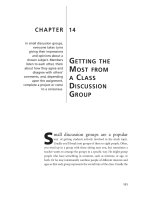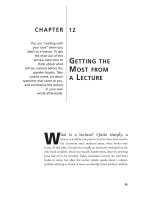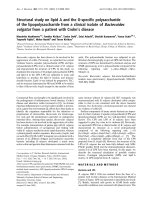Getting the Most from a Lecture
Bạn đang xem bản rút gọn của tài liệu. Xem và tải ngay bản đầy đủ của tài liệu tại đây (110.94 KB, 16 trang )
95
CHAPTER
12
G
ETTING THE
M
OST FROM
A
L
ECTURE
You are “reading with
your ears” when you
listen to a lecture. To get
the most out of the
lecture, take time to
think about what
will be covered before the
speaker begins. Take
careful notes, jot down
questions that come to you,
and summarize the lecture
in your own
words afterwards.
W
hat is a lecture? Quite simply, a
lecture is a talk by one person. Lectures have been used in
the classroom since medieval times, when books were
scarce. At that time, a lecture was usually an instructor reading from the
only book available, which was usually handwritten, since the printing
press had yet to be invented. Today, sometimes lectures are read from
books or notes, but often the teacher simply speaks about a subject,
perhaps referring to a book or notes occasionally. Some teachers combine
HOW TO STUDY
96
lecture with discussion groups; some only lecture. Your job as a student in
a lecture situation is to be an active listener. You want to become involved
with what you’re hearing.
BEFORE THE LECTURE
In any class, it’s a good idea to get the phone numbers of at least two of your
classmates. Then, if you should be ill, you’ll have fellow students to call to
find out what you missed. They might let you copy their notes or their
audiotape of a lecture. If you want to study together—even if it’s over the
phone—or check information, you have potential study buddies. There’s
more to come on this in Chapter 16, “Working with a Study Buddy.”
P
REPARING FOR THE
L
ECTURE
C
LASS
Many schools and companies have lecture halls that can accommodate
fifty or more students. Seats may or may not be assigned. Before you
attend class, you can probably find out from the department or office
sponsoring the class if you may choose your seat. If so, be early! Seats up
front and along the aisles go quickly. Most lecturers permit tape
recorders, but ask for permission first. Whether you learn best by hearing
or seeing, it’s a good idea to take advantage of a tape recorder. Especially
in a large class with many distractions, it’s easy to miss something
that is said.
What’s in a Title?
You’ll probably be given the title of the lecture or the title of a reading
that the lecture is based on. Get yourself tuned up for that lecture by
playing a little guessing game beforehand:
• What do you think the lecture will be about?
• What do you know about the topic already—and what don’t you?
• How will knowing more about the subject enhance your
understanding of the class, or your knowledge in general?
Write in a notebook or record on tape whatever the title of the lec-
ture brings to mind. Write what questions you expect the lecture to
answer, based on what you think about the title. Now that you’ve guessed
what the lecture is about—you’re ready to listen!
GETTING THE MOST FROM A LECTURE
97
Is There an Assignment? Do It!
If the lecture is based on an assignment, such as a reading, it’s important
to have this done—and understood—before the lecture, so you’ll know
what the lecturer is talking about. Write down any questions that come
to mind while you do the assignment, ones that you hope the instructor
will answer in the lecture.
MAKING SENSE OF THE LECTURE
Q
UESTIONS
, Q
UESTIONS
Some instructors permit students to raise their hands and ask ques-
tions during a lecture. Others want to wait until the end of the lecture for
questions. Either way, write down your questions as they come to mind.
Questions can evaporate unless they’re on paper, even if you’ll be asking
them soon.
Coming up with questions also helps you understand the lecture.
For instance, you might be thinking to yourself, “I’m not sure what he’s
talking about right now. I can’t seem to connect it with what he said a
moment ago.” That’s a legitimate question! So you can ask: “I’m having
trouble connecting what you just said with what you were talking about
before. Would you explain the connection for me?”
It’s important to speak up! If you have a question, others are prob-
ably thinking the same thing. You feel more involved when you partici-
pate—and you are getting more out of what you’re learning. Even in lec-
ture classes, instructors often notice—and appreciate—students willing
to participate by asking questions. Sometimes the instructor is so famil-
iar with the material that he or she forgets others need more explanation.
In this sense, you’re helping the teacher teach!
T
AKING
N
OTES
You’ll get more out of note taking if you’re guided by your learning style.
(You may want to review Chapters 2 through 5 on learning styles.)
If You Learn Best by Hearing
Some people who learn best by hearing find that taking notes while they’re
listening distracts them from what they’re hearing. To test this, try both
versions of the practice tip at the end of this chapter. Listen to a talk show
without taking notes, then, on another day, listen to a talk show with taking
HOW TO STUDY
98
notes. Decide which worked better for you. Either way, writing down ques-
tions that come to mind—or even key words that will remind you of the
question—might be necessary to help you hold on to the question.
If You Learn Best by Seeing
You need to “see” while you listen. Write or draw pictures of what the
lecturer is talking about. If the lecturer switches back and forth between
topics, try using different colored markers to denote the different topics.
If you don’t have time to do this while the lecture is going on, you can do
it when you go over your notes after class.
If You Learn Best by Using Images
You need to have pictures come to mind while you listen. Write or draw
pictures of what the lecturer is saying. For your images to make sense,
remember to think about the order of events, too! Numbering your
pictures or using different colors to show you their order might help.
If You Learn Best by Using Order
You need to feel a clear order of events while you listen. Make a list or
draw a timeline of what the lecturer is saying. Remember to keep track of
images, too. Perhaps drawing images on your timeline would be useful.
If You Learn Best by Doing
You need to get a sense of experiencing what is being talked about. You
might need to try different ways to do this, both for doing and for
moving. For doing, you could pretend you’re a reporter for a magazine on
the subject of the lecture and you need to take careful notes so your
readers will have an accurate understanding of the subject. For moving,
you might find that you stay focused best by writing down as much of
what the lecturer is saying as you can, and/or gently tapping your foot or
finger to the lecturer’s rhythm of speech. Just do it so gently that you
don’t disturb others around you.
On the other hand, some people who learn best by doing find that
the simple act of taking notes is enough doing for them. You may not
need to refer to your notes very often after the lecture (once you’ve got-
ten them in order, that is). The simple act of writing down the ideas helps
you remember them.
1.
2.
3.
GETTING THE MOST FROM A LECTURE
99
Try the different ways of listening described above to see which best
helps you listen attentively. Practice them in turn as you listen to a radio
talk show!
REFLECTION AFTER THE LECTURE
Why do you look into a mirror more than once? What do you see that
you haven’t seen before? You have the same face—the same configuration
of eyes, nose, mouth. What’s different each time you look? Is there more
sparkle in your eyes? Less color in your cheeks? A wrinkle on your brow?
When you reflect, you look back on something. Sometimes, on tak-
ing a second look, you realize something you hadn’t noticed before.
Reflecting also helps you remember what happened. The same way you
look into a mirror to make sure the part in your hair is straight, or your
tie knot is tidy, you think back on a lecture to see if everything is in order
in your mind, that all the information falls into place.
Start by considering the questions you wrote (or recorded) before
the lecture began. Were any of them answered during the lecture? How
did your anticipation of the lecture, based on its title, compare with what
was actually said? If you’re left with questions, try to find the answers by
reflecting on what you learned, or by speaking with the professor.
W
RITE OR
D
RAW A
S
UMMARY
Things make sense to you, or “stick” with you, when you’re an involved
learner. You’re able to connect what’s new to what you already know. You
find that your questions now have answers. Pictures come to mind and
the order of events is clearer than before.
Now, while it’s still fresh in your mind, you need to put together a
complete picture of what you heard in the lecture. You need to make a
summary for yourself. In this case, the summary is a condensed version
of the whole lecture. You can go about this in a variety of ways. You can
write it in your notebook, draw a cartoon about it, or speak your
thoughts into a recorder. Any of these methods lets you refer back for a
quick review and helps you remember key ideas.
The summary can be a couple of sentences for starters. Add on to it
as more thoughts come to mind. You might want to have two summaries:
a short one to remind you of what happened, which you can write in the
Try It!
HOW TO STUDY
100
top margin of your notebook or on the label of your audiotape; and a
longer one that includes any details that come to mind. Your notes, after
all, may be several pages in no particular order. Now is the time to make
sense of them. To help you with this, you may want to review Chapter 11,
“Remembering What You’ve Learned.”
U
SING
N
OTES TO
H
ELP
Y
OU
R
EMEMBER
The more you go back to your notes, adding on to them any connections
or questions and answers that come to mind, the greater chance you’ll
have of remembering the material. Re-writing notes can help you put
them in an order that makes more sense to you. If you learn better by
images, re-writing can help you connect your images more clearly. If you
learn better by order, re-writing, perhaps in an outline form, can assist
you in understanding—and remembering—more of what you’ve heard.
Taking notes from your audiotape as you re-listen can help you focus
on what you’re hearing. The more you listen, writing down additional
questions and ideas as they come to mind, the more you’ll get out of your
tape. Treat your taped lecture the same way you would treat a favorite
album: listen to it over and over again.
Since everyone learns differently, keep reminding yourself of what
works for you. You will be more likely to repeat your success in getting a lot
out of the lecture if you also figure out and write down why it was a success.
I
N
S
HORT
Before a lecture begins, pre-read by anticipating what it will be about.
During the lecture, write questions as they come to mind. Then ask them
of the lecturer. Use your learning style—take notes if you learn best by
seeing, focus on listening if you learn best by hearing. After the lecture,
write a summary of what it was about and its value to you.
Find Out!









